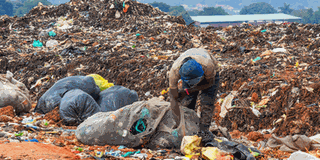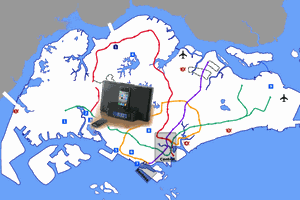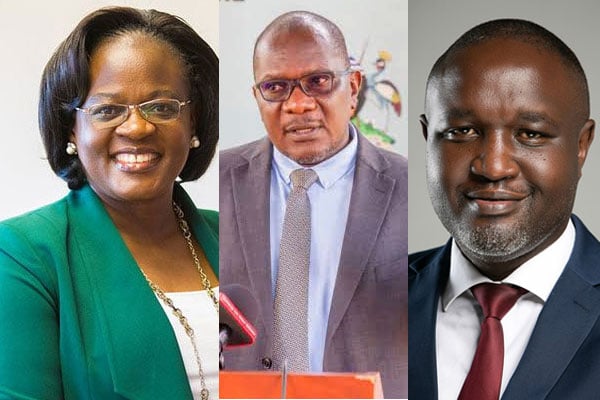
A man sorts items from the garbage at Kiteezi landfill. PHOTO/MICHAEL KAKUMIRIZI
The 62nd independence event is happening when Uganda’s economy is ailing with a worsening trade deficit at $ 247.93 million as of June 2024.
This is in addition to projected debt by the International Monetary Fund (IMF) of $993 million, increasing inequalities in all forms, unemployment, and a predominantly primary commodity export basket.
Tomorrow, Uganda will celebrate her 62nd independence. But what kind of economic independence will you be celebrating when, yet again, the country commemorates the end of decades of British colonial rule?
For about 70 years of colonial British rule, Uganda’s economy was the responsibility of the colonisers whose sole purpose was to economically exploit indigenous resources at the expense of the native Ugandans.
By the time the colonialists surrendered the instruments of power, ushering in self-governance after nearly seven decades, Uganda’s economy, according to World Bank records, was one of the most vibrant and promising in Sub-Saharan Africa.
After independence
Following its independence in 1962, Uganda initially witnessed some economic progress.
At independence, exports of cotton, coffee, tea, grain, copper, and a few manufacturers earned a substantial amount of foreign exchange. Cash crop production was quite strong, with 1965 coffee and cotton production at 218,000 tonnes and 243,000 tonnes, respectively. Copper production was at a historical high in the late 1960s at more than 16,000 tonnes per year.
The study which was authored by the International Monetary Fund team in the 1980ties that included Ms Hema R.De Zoysa, Mr Robert L. Sharer and Mr Calvin A McDonald shows that between 1963 and 1973, the annual average rate of GDP growth was 6 percent. Additionally, the balance of payments was in surplus during most of this period, and inflation was low.
“In 1971, a military regime assumed power under General Idi Amin, and Uganda moved away from the outward-oriented policies pursued in the immediate post-independence period. Local industries were granted significant protection, the size and involvement of the public sector in economic activity expanded considerably, and the Asian community, which had dominated the industrial and commercial sectors, were expelled and their properties expropriated,” the IMF team stated in their study.
They stressed that efficiency and financial discipline suffered, leading to a significant decline in output of about 20 percent during the 1970s.
The IMF team stated that as budgetary revenues collapsed, there was an increasing reliance on domestic bank financing, which intensified inflationary pressures. Despite mounting inflation and the consequent appreciation of the real effective exchange rate, the official exchange rate and agricultural producer prices were kept fixed throughout the 1970s.
“As a result of these policies, significant damage was done to the competitiveness of the economy, and particularly to that of the export sector. By 1980, Uganda had become dependent on one crop—coffee—for 98 percent of its exports,” they said.
Adding: “Reflecting declining incentives on account of the unrealistic exchange rate, the volume of coffee exports in 1980 amounted to barely half the shipments achieved in the early 1970s. The volume of other traditional exports—particularly cotton, tea, and tobacco—became negligible, and copper exports ceased.”
Progress/regression?
Be as it were, the debate as to whether for the last 62 years Uganda has been in better stead economically or simply regressed continues to elicit mixed reactions.
And here is why.
Even after assuming self-governance, the former metropole in this case the colonisers now in the shape and form of Western hegemony, determining what is acceptable and what is not—by controlling the levers of not only political but also economic, social and technological agenda, means it is not yet “Uhuru” – not yet independence.
“From trade liberalisation, privatisation, the abdication of a developmental State, frowning on our cultural norms in favour of the colonialist way of colonialist lenses of looking at things means Uganda hasn’t attained economic independence yet,” researcher Africa Kiiza, said in an interview last week.
According to Mr Kiiza, currently a PhD Fellow, Faculty of Business, Economics and Social Sciences; Universität Hamburg, the 62nd independence event is happening when Uganda’s economy is ailing as evidenced by a worsening trade deficit standing at $ 247.93 million as of June 2024.
This is in addition to projected debt by the International Monetary Fund (IMF) of $993 million, increasing inequalities in all forms, unemployment, and a predominantly primary commodity export basket.
Singapore and South Korea comparisons
In his analysis, Mr Kiiza notes that the independence celebration coincides with a time when Singapore recycles 90 percent of its waste to generate electricity compared to Uganda where only 8 percent which is about 2,330 metric tonnes of waste is recycled but not directed towards powering the economy – electricity.
In 1962, Singapore and South Korea, according to other comparisons, were at the same level of development as Uganda. Singapore’s economy then was valued at $704 million while Uganda’s was in the range of about $720 million.
“Then, Uganda’s economy was slightly bigger than that of Singapore, 62 years later, Singapore has a $525.23 billion economy compared to Uganda’s meagre $50 billion,” researcher Kiiza indicated, before stressing that, “One can also say that Uganda has wasted the 62 years by playing catchup when Singapore is already at the last stage of Rostow’s Economic Growth stage -- the age of high mass consumption.”
But other researchers think this comparison is a little unfair. One such researcher is Mr Paul Corti Lakuma, a senior research fellow at Economic Policy Research Centre (EPRC).
He said in his response last week: “The comparison with Singapore and South Korea is at times unfair. The societies come from different historical backgrounds. For example, unlike Uganda, Singapore is ethnically homogenous, which facilitates the convergence of aspirations.”
Expanding economy
According to the EPRC senior fellow, “Our economy has expanded more than tenfold since 1962, despite the 1970s and 1980s turbulence.”
Researcher Lakuma attributes the impressive GDP growth rates to “peace, security, democracy, household incomes, domestic and foreign investment and government expenditure on critical infrastructure such as roads and electricity.
He also mentioned improved literacy rate currently at (82 percent and increased life expectancy averaging 68 years, and reduced mother mortality (330 deaths out of 100,000 live births) as gains that have since been registered.
However, he notes: “We could do better in diversifying the economy, maintaining existing infrastructure, improving the quality of elementary education, and reducing the monetary cost of our democracy.
“This should be in addition to enhancing value addition and exports, underwriting regional stability, creating employment, and facilitating efficient use of factors of production such as land as well as investing in our people by encouraging investment while being careful not to saddle the economy in debt.”

Farmers dehuski rice in Butaleja district on May 16, 2024. Uganda has an ambitious dream of catapulting the economy from the present $50 billion to $500 billion over the next one and half decades. PHOTO/MICHAEL KAKUMIRIZI
Cut some slack
Despite some misgivings, Mr Kiiza in his analysis realises some commendable economic gains registered since independence.
At Independence, Uganda’s economy was concentrated in the 3Cs – coffee, cotton and copper; and the 3Ts -- tobacco, tea and tourism. While these are still part of Uganda’s trade basket, there has been diversification with other exports such as cereals, dairy, beef, fish, and oil seeds among others often in value-added form.
A report by the Ministry of Finance in April 2024 notes that Uganda’s export revenue of goods and services was $7.471 billion for the calendar year ending April 2024 compared to $ 4,938 for the year ending April 2023.
This is not to mention the growing services sector which has been growing at 6 percent for the past five years and investment in value addition and trade facilitating infrastructure like roads, electricity, and industrial parks among others.
However, there is still a lot to do.
The International Trade Centre (ITC) Trade Map notes that Uganda’s total unrealised export potential currently stands at $3.1 billion. For example, while Uganda’s export potential for coffee is $ 850 million, her actual exports currently stand at $657 million with an unrealised potential of $255 million.
Uganda also has an untapped export potential of $56 million for milk, $11 million for millet, $12 million for flat rolled iron, and $47 million for cane sugar among others. Uganda also lacks trade facilitation infrastructure like cold chains (the few available are expensive and charge a cost of $10 daily per cubic meter) and one-stop cargo consolidation centres/hubs (the existing ones are concentrated in urban centres yet 90 percent of producers are MSMEs largely in rural areas).
While there are some improvements in the road network, the country’s transport and logistics industry is small, weak, informal, fragmented, and inefficient, and is estimated by the World Bank to cost the country Shs3 trillion annually.
At the company level, transport, and automobile expenses alone account for 17.4 percent of the manufacturing firm’s cost, the transport margins for industrial goods are equally high with estimates ranging between 40-50 percent, while the percentage of transport costs to the total cost of products in agriculture is estimated at 60-70 percent in terms of agricultural inputs like seed.
As of October 2023, Uganda’s Agricultural seed import shipments in Uganda stood at 68 percent, imported by 22 Ugandan importers from 24 suppliers. For example, in 2022, statistics by MAAIF show that Uganda imported 870 shipments of cabbage, 522 shipments of watermelon seeds, 191 shipments of tomato seeds from India, 1,060 tonnes of maize from South Africa and Zimbabwe and 13 tonnes of sorghum from Israel and Kenya.
“All these show that as we celebrate 62 years of independence, we should think of measures to not only grow our economy but also ensure that this growth is felt in the pockets of the citizens,” says Mr Kiiza.
Way to go
Uganda has an ambitious dream of catapulting the economy from the present $ 50 billion to $ 500 billion over the next one and half decades.
“We need to scale up value addition,” the executive director of Uganda Manufactures Association told Prosper Magazine last week. This is a position that analysts like Mr Kiiza and Mr Lakuma, including economic sector players across concur with.
For example, while Ugandan coffee farmers are paid an equivalent of $70 cents per kg of low-grade coffee, the same kilogramme, when roasted, ground into powder and packaged, sells for $12.9 in a Supermarket.
While Uganda is home to the world’s purest Iron ore – estimated at 70 percent pure, followed by Peru at 50 percent pure, researcher Kiiza’s findings show that Uganda imports over $ 362 million of steel and steel products annually.
This means that the government should be involved in economic development and shouldn't solely relegate it to private players as has been the case in most of the NRM leadership. Sector players and analysts spoken to for this article recommend government efforts in scaling and enriching iron ore for steel production is the right way to go. If done, it would give Uganda the capacity to supply East Africa’s demand for steel and steel products which is at about $2.5 billion annually.
The government should provide an incentive regime for private sector investment in logistics hubs across the country and most especially on key border posts as a critical trade facilitation infrastructure. This is critical for maintaining the freshness and quality of essential products like fruits, vegetables and oils.
These should be located near major production areas. The government expedited plans to establish the Standard Guage Railway as this would reduce the cost of freight transportation from Mombasa to Kampala from USD 0.16 per tonne-km to about USD 0.03 per tonne-km.
This should be extended to the Mutukula border post. The government should also support Uganda Air Cargo Corporation (UACC) with cargo planes to provide quick delivery of goods in regional and global markets.
To complement this, the government should also explore Water as a viable and safer alternative means of transport for cargo by increasing cargo ships through government investments and PPPs. A study by the East Africa Marine Transport (EAMT) project reveals that this would lower freight costs and save the economy approximately US$2 to $3 million in the first year alone.
“Finally, we cannot negate the role of pragmatic leadership in all this dream. Singapore’s progress was hinged on three models including meritocracy, pragmatism and honesty -- MPH.
“At 62, Uganda loses over Shs10 trillion annually due to corruption and has a civil service which is woven along specific family and cultural lines rather than merit. Transforming the economy will require much more than throwing money at villagers under the Parish Development Model. It takes appointing the right technocrats, heavily punishing corruption and rewarding meritocracy which is a real fundamental change,” researcher Kiiza wrote in his expert analysis to Prosper Magazine.





